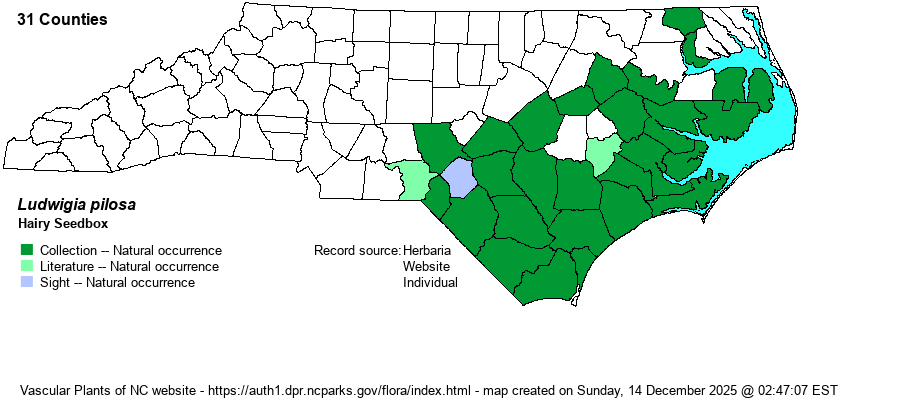| Author | Walter | |
| Distribution | Present over most of the Coastal Plain, but sparse in the northern third, and likely absent from parts of that region. Ranges west to include the Sandhills region.
This is a Southern Coastal Plain species, ranging from southeastern VA to southern FL and west to eastern TX. | |
| Abundance | Frequent to common in the southern half of the Coastal Plain, but rare in the northern portions. | |
| Habitat | This species grows with its "feet" wet, usually growing in ditches, canal borders, pools, pond edges, and other areas of standing water. | |
| Phenology | Blooms from June to October, and fruits shortly after flowering. | |
| Identification | This is a quite familiar Ludwigia to biologists working the Coastal Plain. It is quite pubescent overall, growing to about 2-3 feet tall, with numerous branches. The scattered, alternate leaves are lanceolate, about 2-3 inches long and about 2/3-inch wide, essentially sessile, but certainly quite hairy. The flowers grows both in leaf axils and near branch tips, having no petals, but the 4 sepals are colored light yellow to cream-yellow; they are triangular to ovate and the spread flower is about 1/3-inch across. The capsule is quite hairy and is bell-shaped, but only 1/5-inch long. Note that L. ravenii, which was pulled out from L. pilosa in 1984, is very similar. It has green sepals (flowers), instead of pale yellow flowers, and it has a few small differences in sepal and capsule characters. Check that species account for more details, or check Weakley (2018). The overall very hairy nature of this species, almost always growing in standing water, should preclude confusion with other species (except for L. ravenii). And, there are enough pale yellow flowers to attract attention, especially as the species usually grows in sizable, dense stands. | |
| Taxonomic Comments | None. However, L. ravenii was described in 1984, pulling out some of the older records of L. pilosa to that rare and poorly known species.
| |
| Other Common Name(s) | Hairy Primrose-willow, Hairy Water-primrose | |
| State Rank | S4 | |
| Global Rank | G5 | |
| State Status | | |
| US Status | | |
| USACE-agcp | OBL link |
| USACE-emp | OBL link |

